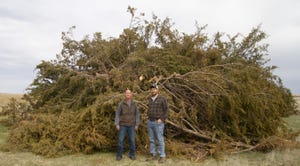Bust Pinkeye By Getting & Staying Ahead Of It
April 2, 2010

Growing up in Missouri, I saw firsthand the wonderful benefits that heat, humidity and high rainfall provide a fly population. Aside from the devastating production losses in cattle that result from simple irritation by flies, one of the most discouraging problems is preventing face flies from spreading the causative agent of pinkeye, Moraxella bovis.
Pinkeye is a painful disease that can cause reductions in weaning weights of as much as 17-65 lbs./animal. Once pinkeye begins to spread through a herd, it’s very difficult to contain and control.
Face flies play an important role in the spread of pinkeye, as the irritated eye produces excessive tearing that attracts the pests. Face flies then pick up the causative agent of pinkeye and transfer it to other animals.
In comparison to horn flies, face flies actually spend very little time on the animal. So, one face fly can spread pinkeye to several animals in the same day. That’s why it’s very important to get aggressive about pinkeye control as soon as signs are seen.
In most situations, the first step in gaining control of pinkeye is to control the flies. There are several options for fly control, including fly tags, pour-ons, sprays, dust bags and back rubbers.
Fly tags perform best when administered at the proper time. Unfortunately, this usually means cattle must be brought in for the sole purpose of administering fly tags, as spring branding, castrating, dehorning and vaccinating are frequently completed prior to the optimal time for fly-tag administration. Thus, fly tags are often administered as much as 60 days prior to fly season, which compromises the tag’s efficacy. By the way, fly tagging cows is actually more effective than fly tagging calves, but tagging both is best.
There are several pinkeye vaccines that may help; consult your herd health veterinarian about the timing of vaccination and which vaccine to use in your area. Many of these vaccines require a booster dose for greater efficacy, which could actually work to our advantage. Since calves must be brought in for a second dose of vaccine, fly tags can also be administered at a time closer to the start of fly season.
The key to treatment is catching the disease early. Generally, a long-acting oxytetracycline antibiotic is very effective against Moraxella bovis, but resistance isn’t uncommon. In this case, your herd-health veterinarian may need to conduct a culture and sensitivity test to determine to which antibiotic the bacteria is sensitive.
Another key component to treating pinkeye is protecting the eye from sunlight, which is just as important as the antibiotic. Because ultraviolet rays can activate enzymes that cause more damage to the eye when the eye is infected with M. bovis, eyepatches are very effective in protecting the eyes from sunlight. The challenge is keeping the eyepatch on the animal.
I’ve used construction adhesive (Liquid Nails) on eyepatches with great success – perhaps too much so, as many times, I have had to catch the calf later and pull the patch off. But, as long as the patch stayed on for the first 20 minutes, I didn't have to worry about it coming off too soon. For severe pinkeye, consider having your veterinarian suture the eyelid shut to protect the eye from light.
Pasture management is another component of pinkeye control. Grass that is headed out can irritate eyes, causing them to tear and thus attracting face flies. Keeping pastures trimmed can reduce this irritation.
The best way to deal with pinkeye is to get ahead of it and stay ahead of it. Do this by using a broad-based approach that includes fly control, vaccination and pasture management. Consult with your herd-health veterinarian to develop a program tailored to your operation.
-- Dave Sjeklocha, DVM, Haskell County Animal Hospital, Sublette, KS .
You May Also Like
.png?width=300&auto=webp&quality=80&disable=upscale)


